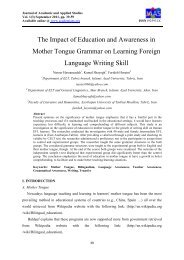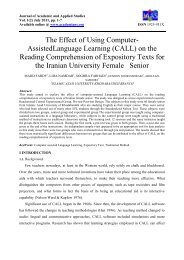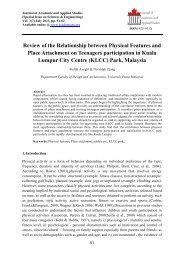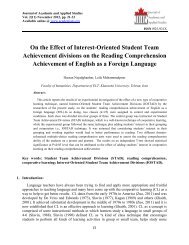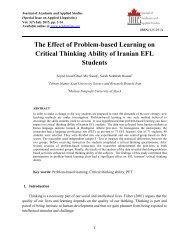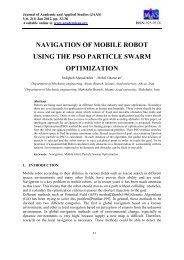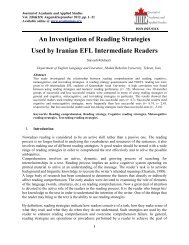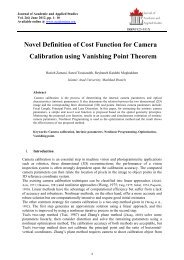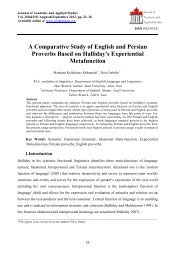Franck-Hertz Experiment and Identification Materials - Journal of ...
Franck-Hertz Experiment and Identification Materials - Journal of ...
Franck-Hertz Experiment and Identification Materials - Journal of ...
Create successful ePaper yourself
Turn your PDF publications into a flip-book with our unique Google optimized e-Paper software.
<strong>Journal</strong> <strong>of</strong> Academic <strong>and</strong> Applied StudiesVol. 3(3) March 2013, pp. 34-39Available online @ www.academians.orgISSN1925-931X<strong>Franck</strong>-<strong>Hertz</strong> <strong>Experiment</strong> <strong>and</strong> <strong>Identification</strong> <strong>Materials</strong>B.BaghbanzadehDepartment <strong>of</strong> Physics, Dezful Branch , Islamic Azad University, DEZFUL, IRANAbstractThe Bohr theory was verified experimentally by <strong>Franck</strong> <strong>and</strong> <strong>Hertz</strong> in 1914 ,by passing a beam <strong>of</strong> electronsaccelerated by an electric field through gases. At first, the electron beam was passed through mercury vapor.The electrons collide with the mercury atoms. These collisions may be <strong>of</strong> any one <strong>of</strong> two kinds. One kindin elastic collisions which do not change the velocity or energy <strong>of</strong> the electrons, <strong>and</strong> only change thedirection <strong>of</strong> their velocities. The other kind is inelastic collisions in which the electrons transfer some <strong>of</strong>their energy to the mercury vapor. A similar effect is observed with neon gas. The process <strong>of</strong> absorbingenergy from electron collisions produces visible evidence. When the accelerated electrons excite theelectrons in neon to upper states, they de-excite in such a way as to produce a visible glow in the gas regionin which the excitation is taking place. By extension, conducting this experiment on different materialsallows the energy level <strong>of</strong> the electrons in a material to be discovered. <strong>Materials</strong> might be identified in thisway. A sample could be experimented on <strong>and</strong> the energy level <strong>of</strong> the material discovered <strong>and</strong> compared toknow materials thus revealing its identity.Keywords: <strong>Franck</strong>-<strong>Hertz</strong> experiment, Mercury, Collision, ElectronI. INTRODUCTIONThe experimental set-up is shown in figure 1 .in this set-up arranged inside a glass envelopewhich also held an amount <strong>of</strong> mercury to produce mercury vapor under a pressure <strong>of</strong> about 0.1mm Hg. The cathode was raised to inc<strong>and</strong>escence <strong>and</strong> emitted electrons, <strong>and</strong> the anode wasconnected to a galvanometer .The difference <strong>of</strong> potential between the cathode <strong>and</strong> the grid set upan electric field which accelerated the electrons to an energy eV 1 where V 1 is the difference <strong>of</strong>potential between the cathode <strong>and</strong> the grid ,<strong>and</strong> e is the electronic charge . The electric fieldbetween the grid <strong>and</strong> the anode was a weak retarding one, due to a potential difference, V 2 <strong>of</strong> notmore than 0.5 V. Anode is charged negatively in comparison with grid .Therefore only electronswith energy larger than eV 2 can reach the anode <strong>and</strong> cause a current signal. If V 2 =0 , all electronswould reach the anode <strong>and</strong> no modulation <strong>of</strong> the current signal could be measured.
<strong>Journal</strong> <strong>of</strong> Academic <strong>and</strong> Applied StudiesVol. 3(3) March 2013, pp. 34-39Available online @ www.academians.orgISSN1925-931XFig.1 The <strong>Franck</strong>-<strong>Hertz</strong> tube <strong>and</strong> electrical connections. K is the cathode , G is the grid <strong>and</strong> A is anodeOn passing through mercury vapor, the electrons collide with the mercury atoms. Thesecollisions may be <strong>of</strong> any one <strong>of</strong> two kinds. One kind is elastic collisions which do not change thevelocity or energy <strong>of</strong> the electrons <strong>and</strong> only change the direction <strong>of</strong> their velocities. The otherkind is inelastic collisions in which the electrons transfer some <strong>of</strong> their energy to the mercuryvapor .Since the electron mass is much lower than the mass <strong>of</strong> a mercury atom electrons hardlylose energy in elastic collisions, ∆E ∝ 4m ebut only change their direction. Therefore them Hgprocesses we are interested in must be caused by inelastic collisions, in which a fraction <strong>of</strong> theelectron energy is converted into internal, in our case excitational energy <strong>of</strong> the atom.Fig.2 If the incoming electron has a kinetic energy which is less than the difference delta E between mercury s n =1<strong>and</strong> n =2 energy levels , then it simply bounces <strong>of</strong>f elastically , keeping all its original kinetic energyElastic collisions between the electrons <strong>and</strong> the mercury atoms cannot prevent the electrons fromreaching the anode. Therefore, they cannot affect the value <strong>of</strong> anode current through the mercury– vapor tube, which is solely controlled by the accelerating field or, rather, by the potentialdifference between the cathode <strong>and</strong> the grid. In constant, during inelastic collisions the electronsmay lose so much <strong>of</strong> their energy that they will not be able to overcome the weak retarding fieldbetween the grid <strong>and</strong> the anode, <strong>and</strong> anode current may drop to practically zero. According to35
<strong>Journal</strong> <strong>of</strong> Academic <strong>and</strong> Applied StudiesVol. 3(3) March 2013, pp. 34-39Available online @ www.academians.orgISSN1925-931XBohrs first postulate, the amount <strong>of</strong> energy that a mercury atom can receive from a collidingelectron is just sufficient for the atom to undergo a transition to one <strong>of</strong> excited states. The excitedstate nearest to the ground or normal state for a mercury atom is separated by an energy gap <strong>of</strong>4.88 ev.Fig.3 If the electron has kinetic energy equal to delta E , then it transfers most <strong>of</strong> its kinetic energy to the mercuryatom , boosting the atom to the n=2 state . That levels the electron with very little kinetic energyUntil the electrons accelerated by the field acquire an energy <strong>of</strong> ev 1 = 4.86e, they experience onlyelastic collisions in which they lose no energy <strong>and</strong> reach the anode so that anode current is rising.As soon as an electron gains an energy <strong>of</strong> 4.86 ev an inelastic collision may take place, theelectron may transfer all <strong>of</strong> its energy to a mercury atom, <strong>and</strong> this may jump from the groundinto the excited state . Obviously, the electron cannot now overcome the weak retarding fieldbetween t grid <strong>and</strong> the anode <strong>and</strong> will fail to reach the anode. Thus at a potential difference <strong>of</strong>4.86 V between the cathode <strong>and</strong> the grid , anode current should show a sudden decrease . Similarevents should happen when the potential difference is 2×4.86V, 3x4.86v, etc. that is, whenelectrons may experience two , three or more inelastic collisions. This relation between anodecurrent <strong>and</strong> the difference in potential, V 1 , between cathode <strong>and</strong> grid in the <strong>Franck</strong>-hertzexperiment is shown in the plot <strong>of</strong> fig .2 . As is seen , anode current suddenly decreases at V 1equal to 4.86 V , 9.72 V <strong>and</strong> 14.58 V , in accordance with Bohr s first postulate .[1]The <strong>Franck</strong> –<strong>Hertz</strong> experiments came as a pro<strong>of</strong> <strong>of</strong> Bohr s third postulate in the following way.The mercury vapor in the tube was noted to emit ultraviolet light at a wavelength <strong>of</strong> 2537 A.This emission is explained by the fact that the mercury atoms excited by their collisions withelectrons can reside in an excited state for a very short time interval, about 10 -8s ,<strong>and</strong> then jumpback to their ground or normal state . According to Bohr S Third postulate, each transition <strong>of</strong> anatom to its ground state is accompanied by the emission <strong>of</strong> a quantum <strong>of</strong> radiant energy , or aphoton <strong>of</strong> magnitude ∆E = hθ .From ∆E = 4.86eV ,where e=1.6×10 -19 c is the electronic charge , the wavelength <strong>of</strong> emittedlight is found to be λ = c θ = hc∆E = 2537A°36
<strong>Journal</strong> <strong>of</strong> Academic <strong>and</strong> Applied StudiesVol. 3(3) March 2013, pp. 34-39Available online @ www.academians.orgISSN1925-931XFig.4 Accelerating voltage versus anode currentThis result fully checks with experiment, for mercury vapor emits primarily this wavelength.Bohr s theory contributed immensely to the establishment <strong>of</strong> atomic physics. While it was in themaking between 1913 <strong>and</strong> 1925, very important discoveries were made. These discoveries addedto the wealth <strong>of</strong> present –day physics. Bohr s theory was especially stimulating to the advances<strong>of</strong> atomic <strong>and</strong>, partly, molecular spectroscopy. On the basis <strong>of</strong> Bohr s theory, a hugeaccumulation <strong>of</strong> experimental data on the spectra <strong>of</strong> atoms <strong>and</strong> molecules was presented in asystematic way <strong>and</strong> reduced to semi-empirical relations. Yet, Bohr theory showed somedrawbacks from the outset .The most important among them was its inherent inconsistencybecause it was an attempt to reconcile classical physics <strong>and</strong> quantum – theoretical postulates.The gravest failure <strong>of</strong> Bohr theory was its inadequacy as regards helium <strong>and</strong> generally anysystem with a nucleus <strong>and</strong> more than one electron. Further developments showed that, successfulin explaining some facts <strong>and</strong> incapable <strong>of</strong> interpreting others, Bohr s theory was a stepping stoneto a consistent theory <strong>of</strong> atomic <strong>and</strong> nuclear phenomena, quantum mechanics [2].II. MATERIAL AND METHODIn the beginning we adjust voltage furnace at 120 V <strong>and</strong> when the temperature <strong>of</strong> furnacereached to 120 C then adjust voltage furnace on 75 V until changes <strong>of</strong> temperature is slower <strong>and</strong>slow to arrive 155 C. After the furnace reached to 155 C ,voltage disconnected until temperaturein this point remain fix. If the temperature is reduced the furnace is connecting voltage again.This cut <strong>of</strong>f <strong>and</strong> connect voltage will continue until temperature does not change. Begin the test,after 20 minute the tube was placed in the position. We recorded changes <strong>of</strong> current by changes<strong>of</strong> voltage.TABLE1.CURRENT BY VOLTAGEVoltage Current(V) (x0.05μA)556677889910711837
<strong>Journal</strong> <strong>of</strong> Academic <strong>and</strong> Applied StudiesVol. 3(3) March 2013, pp. 34-39Available online @ www.academians.orgISSN1925-931X12131415161718192021222324252627282930910119101112131011121314111213141513201000 20 40Series1Fig.5 Anode current curveIII. RESULTSThe <strong>Franck</strong>-<strong>Hertz</strong> experiment is one <strong>of</strong> the basic experiments <strong>of</strong> atomic physics. The results <strong>of</strong>experiment provided strong evidence that Bohr s model <strong>of</strong> atoms with quantized energy levelswas correct. Electrons emitted from a heated cathode are accelerated by a potential difference asthey pass through a mercury vapor. When they have gained sufficient energy, the electronscollide in elastically with mercury atoms exciting them from the ground state. Electrons arecollected at the anode, <strong>and</strong> the anode current shows minima <strong>and</strong> maxima at potential differencesrelated to the energy difference between the ground state <strong>and</strong> the lowest lying excited states <strong>of</strong>the mercury atom [3].IV.REFERENCES1-B.M.YAVORSKY <strong>and</strong> A.A. PINSKY “Fundamentals <strong>of</strong> physics “ chapter 71,page 272-2742-Weidner R.T. <strong>and</strong> Sells R. Elementary Modern Physics Allyn <strong>and</strong> Bacon ,19733-Classical justification <strong>of</strong> the <strong>Franck</strong> hertz experiment ,Hamid v.Ansari, September 19,20074-young <strong>and</strong> R.A. Freedman ,University Physics ,12 th Edition 20095-Christ<strong>of</strong>er Bronner, Frank Essenberger .Freie university Berlin .franck- <strong>Hertz</strong> experiment, September30,200638
<strong>Journal</strong> <strong>of</strong> Academic <strong>and</strong> Applied StudiesVol. 3(3) March 2013, pp. 34-39Available online @ www.academians.orgISSN1925-931X6-Modern physics laboratory ,Physics 286, spring 2010,experiment 4:the <strong>Franck</strong> <strong>Hertz</strong> experiment,Electronic Excitions <strong>of</strong> a gas , <strong>and</strong> Evidence for the quantization <strong>of</strong> atomic energy levels ,University <strong>of</strong> Massachusetts Amherst39



